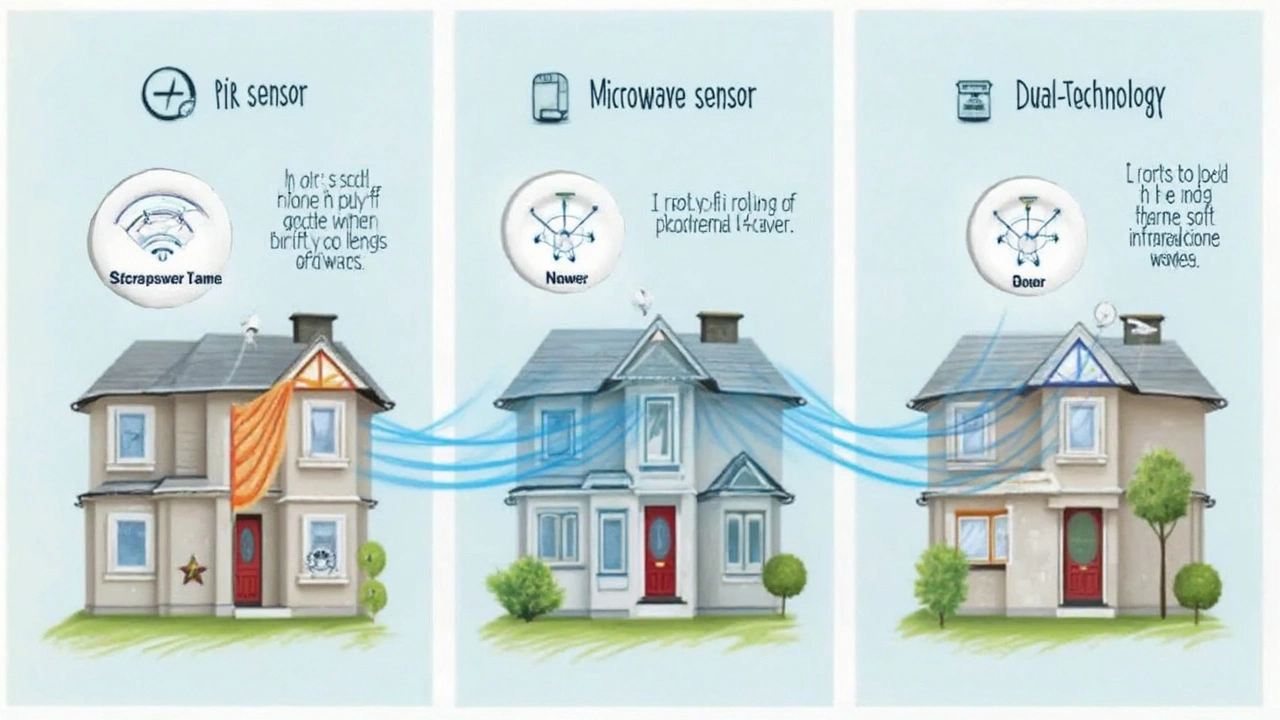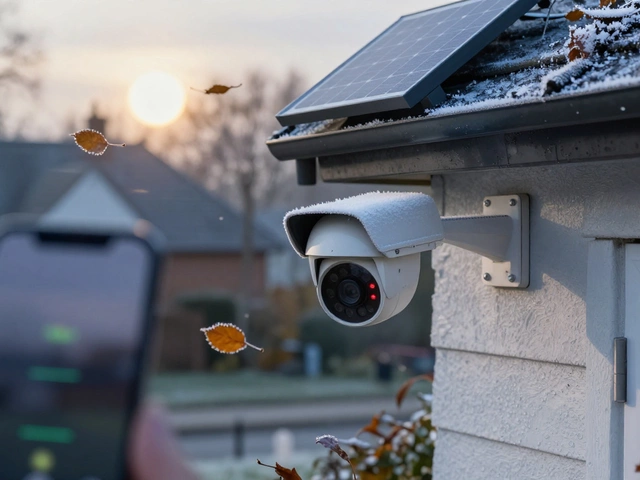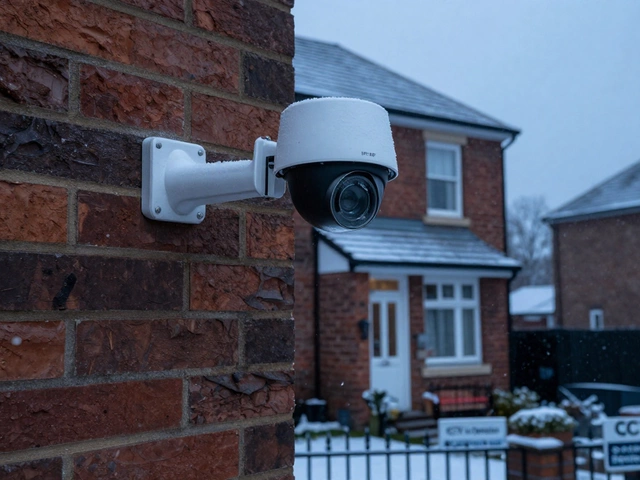Ever noticed your porch light turning on even when nobody’s there, or staying dark right as you stumble up the steps? That’s your motion sensor at work—or not working as well as it could. There are actually three main types of motion sensors behind those lights: Passive Infrared (PIR), Microwave, and something called Dual-Technology.
Each type spots movement in a different way. That explains why some sensors get tripped by pets or trees swaying in the wind, while others are more selective. Knowing which sensor is inside your outdoor light isn’t just tech trivia—it can mean the difference between catching an intruder or dealing with a parade of false alarms every night.
If you’re planning to replace or install security lighting, picking the right motion sensor makes all the difference. One quick tip: not every sensor works everywhere. Before you buy, it’s smart to know what you’re really getting—and what’s just clever marketing.
- Meet the Three Types: PIR, Microwave, and Dual-Technology
- How Each Sensor Detects Motion
- Where Each Sensor Works Best
- Smart Tips for Choosing Your Motion Sensor
Meet the Three Types: PIR, Microwave, and Dual-Technology
Not all motion sensors are built the same, so let’s break down the real differences. The market's main players are Passive Infrared (PIR), Microwave, and Dual-Technology sensors. Each one is designed to notice movement, but the way they do it couldn’t be more different.
PIR sensors are everywhere—over 90% of standard motion sensor lights use them. PIR stands for Passive Infrared. These guys pick up heat signatures, so when a warm body (like a person, or sometimes a dog) passes through their field of view, they signal your light to switch on. Most of the time, they’re tuned to avoid false alarms from small pets, but even a sunlit branch can sometimes mess with them on a hot day. Their popularity boils down to two things: low cost and solid reliability for most home setups.
Microwave sensors work more like radar guns. They send out waves and wait for the signal to bounce back. If something disrupts the pattern—like you walking into a room—they notice. Microwave sensors aren’t thrown off by temperature, so they’re handy when you need to pick up motion through thin walls, glass, or in cold garages. But there’s a catch: they can be triggered by cars on the street or passing traffic, which is why they’re not the first choice for every porch or driveway.
Dual-Technology sensors pack both PIR and Microwave tech into the same unit. Why? Using both systems together can cut down on false alarms. The sensor only reacts when both PIR and Microwave detect movement at the same time. It’s a smart move for places like offices or warehouses where you want lights on for actual people, not drifting shadows or passing cars. They're slightly pricier, but they deliver peace of mind—especially in spots prone to false trips.
| Type | How It Works | Where It's Best | Common Issue |
|---|---|---|---|
| PIR | Senses body heat | Porches, hallways, home exteriors | Heated air or pets can trigger |
| Microwave | Sends radio waves, detects changes | Large rooms, behind thin barriers | May pick up movement outside walls |
| Dual-Technology | Uses both PIR & Microwave | Offices, schools, tricky environments | Costs more up front |
Choosing between these isn’t just about price; think about what false alarms might drive you crazy, and how sensitive your space needs to be. There’s no “one sensor fits all” answer, but knowing which type you’re dealing with already puts you ahead of the game.
How Each Sensor Detects Motion
PIR, microwave, and dual-technology sensors all spot movement, but each works totally differently. Let’s break it down, because knowing the difference is a game changer when you’re shopping for motion sensors for your lights.
Passive Infrared (PIR) Sensors: These are the ones most people run into first. PIR sensors look for changes in heat, picking up the infrared energy that humans, animals, and even cars give off. When something warm enters their field of view, they flip the light on. They ignore non-living stuff, so blowing leaves or rain don’t usually trigger them. But if you’ve got a big dog, expect some false alarms. Their usual detection range is about 30 feet (9 meters), and they’re super energy efficient.
Microwave Sensors: These work kind of like police radar guns. They send out microwave pulses and watch for any bounce-back changes that signal motion. This means they can see through thin walls, glass, or plastic—handy for some setups but a pain if you have traffic nearby. They’re more sensitive than PIR sensors, often picking up motion up to 100 feet (30 meters) away. However, that extra range can be a double-edged sword if you don’t want every passing car setting off your lights. They do need more power than PIR models.
Dual-Technology Sensors: These mash up PIR and microwave sensors into one unit. Both systems have to agree that there’s movement before the sensor triggers the light. This double-check seriously reduces false alarms. The flip side is that if one part fails, the whole system might stop working, so quality matters. These are perfect when you want reliability without constant unwanted light-ups.
Here’s a quick rundown on how each sensor performs in key areas:
| Sensor Type | Main Detection Method | Typical Range | Common False Alarms | Power Use |
|---|---|---|---|---|
| PIR | Body heat (infrared) | Up to 30 ft (9 m) | Pets, direct sunlight | Low |
| Microwave | Radar waves | Up to 100 ft (30 m) | Cars, people behind thin walls | Moderate |
| Dual-Technology | Both heat & radar | Varies | Minimal | Moderate |
Pro tip: If you want light only when it’s really needed—for example, at the back of your garage or along a fence—go for dual-technology sensors. They’re usually worth the extra cash for peace of mind and accuracy.

Where Each Sensor Works Best
So here’s the thing—where you stick each type of motion sensor makes all the difference. If you put the wrong one in the wrong spot, you’ll either get too many false alarms or flat-out miss what matters most. Let’s break it down.
Passive Infrared (PIR) sensors are king for most home setups. They only react to body heat from people or animals moving across their field of view. So, they’re pretty solid for:
- Porches and patios
- Hallways and stairwells inside the house
- Backyards, as long as direct sunlight or heat sources aren’t blasting them
If your area doesn’t see a lot of cars driving by or random heat sources, PIR is a win. Just don’t point one at waving trees or facing a vent—they'll get confused and light up for nothing.
Microwave sensors are different. They send out microwave pulses and check for changes in the reflection. They're a lot more sensitive, which makes them great for:
- Warehouses with thick walls
- Long driveways where you want to spot cars pulling in
- Outdoor spaces where you need a wide detection area—but nobody wants lights flicking on for the neighbor’s cat
The thing is, microwave sensors can shoot right through thin walls or glass. So, if you put these inside and you’ve got small rooms or thin walls, you’ll probably trigger the sensor from another room. Not ideal in an apartment!
Dual-Technology sensors are the heavy hitters. These mix PIR and microwave in the same unit. Both sensors have to be tripped together, so you cut down on the weird false alarms from one sensor acting up. They’re best for:
- Office buildings or shops with lots of foot traffic
- Schools or hospitals
- Outside areas with wind, pets, or moving bushes
Here’s a practical look at which motion sensor lands best in some common spots:
| Location | Best Sensor | Why It Works |
|---|---|---|
| Front Porch | PIR | Doesn't pick up cars on the street, just people at the door |
| Warehouse | Microwave | Penetrates obstacles, covers huge spaces |
| Yard with Pets | Dual-Technology | Cuts down false triggers from animals or wind |
| Office Hallways | Dual-Technology | Handles lots of movement, less chance of lights flicking on randomly |
Bottom line: matching a motion sensors type to your space saves you hassle and keeps things running smoothly. If you’re not sure, go dual-tech in weird or busy spots and PIR where you want to keep things simple.
Smart Tips for Choosing Your Motion Sensor
Picking the right motion sensors for your lights can save you a ton of headaches, not to mention extra electricity costs and pointless alerts.
Here’s a short rule of thumb: match the sensor type to your location and needs. PIR is good for most homes because it doesn’t freak out over leaves blowing or cars passing by. Microwave sensors are super sensitive and can spot motion through thin walls, so use them in big warehouses or places with lots of hidden nooks. Dual-technology sensors combine both so you get fewer false alarms—but they’re pricier.
- Think about pet traffic: PIR sensors are less likely to trigger for a cat or dog, especially if you get one with “pet immunity.”
- Watch your range: Don’t be wowed by giant numbers. Most home driveways and porches need less than 40 feet of range—otherwise, you’ll light up the block every time a neighbor walks by.
- Mounting height matters: Sensors work best when installed between six and ten feet high.
- Don't ignore weather ratings: If the sensor is going outside, check for weatherproof ratings, like IP65 or higher. Otherwise, you’ll be buying another sensor after the first big rain.
More expensive doesn’t always mean better. Instead, think about these three questions before you shop:
- Where do you need the light to trigger? (Side yard, busy walkway, staircase?)
- What might set off false triggers? (Pets, branches, busy road?)
- Are you okay with a little wiring, or is plug-and-play more your style?
A 2024 market study from Statista shows that dual-technology sensors have been gaining ground—mostly in commercial settings. Homeowners still pick PIR sensors for about 65% of new outdoor light installs, mostly for the balance of cost and reliability.
| Sensor Type | % Used in US Homes (2024) | Avg. Price (USD) |
|---|---|---|
| PIR | 65% | $12–$30 |
| Microwave | 20% | $20–$50 |
| Dual-Technology | 15% | $35–$80 |
If you’re feeling lost, don’t sweat it. Lots of people just want a sensor light that works without a fuss. As Anna Lee, lead engineer at SafeHome Security, puts it:
“If you want reliability and you’re not running a nightclub or a warehouse, stick with a good PIR sensor mounted high and facing away from traffic. Ninety percent of problems come from bad placement, not bad sensors.”
So before you buy, walk outside, look at your mounting spot, and picture how everyday stuff—dogs, neighbors, weather—could affect your setup. Get those details right, and you’ll finally have motion sensor lights that just work.






